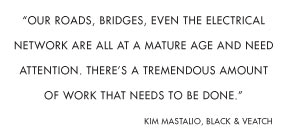Failure to exploit new techniques is not an option. Power plants or water treatment systems built by older, less efficient standards will become as unpopular as $4 a gallon gasoline. “Consider what it means if your electric bill doubles in 10 years,” Mastalio noted.
A significant problem facing the industry: finding skilled laborers to provide the work. Several of the construction industry’s key trades are already facing a shortage of workers that appears likely to worsen.
“Those jobs aren’t always considered to be the attractive jobs that kids look for,” Graves said. “As a result, we’re seeing a shortage of iron workers and bricklayers. That’s a great shame, because who wouldn’t want to work for a J.E. Dunn and earn the kind of money that those positions earn?”

NEW WAYS OF DOING BUSINESS
An example of procedural changes is visible in Missouri’s “Safe and Sound” program, which could be a landmark method for testing and upgrading some 800 bridges across the state. In something of a design-build on steroids, the Missouri Department of Transportation (MoDot) is considering a long-term contract with a single, “infrastructure developer” who will upgrade or replace the worst bridges, then maintain them for 25 years. Though still in the negotiation process, the plan is designed to bring savings in scale and private efficiencies.
“Everyone in the country is watching MoDot on this,” Smith said. “It also includes a new level of preventative maintenance and the idea of locking the work in at today’s prices. It’s the first of its kind in the country.”
Technology allows some procedures that would have been unthinkable in the past. “In Salt Lake they’re building freeway bridges completely off-site, then picking up the whole thing and moving them overnight,” Smith said. “That el-iminates long interstate closures as a bridge is constructed piecemeal.” The location for this bridge construction, which can involve 100-foot spans, is called a “bridge farm.”
Another factor driving up costs involves the commodities of construction, including steel, wood and even gravel. Although the increases have recently leveled somewhat, upward trends are liable to continue. “A lot of it is the global economy,” Mastalio said. “Especially with China and India, worldwide demand has gone up tremendously. Equipment is also up because there are fewer suppliers.”
Burns and McDonnell’s Roger Dickagreed. “Globalization is probably the biggest trend in terms of sheer demand. It also affects the supply of raw materials such as steel as more nations compete with the United States for the foundations of construction.”
Mastalio said local governments, utility companies and other big construction customers will need to do a lot of education in order to prepare the public for changes and probable cost increases. “Consumers are desiring a lot of things that will be expensive,” he said. “New technology can help—we’re still pretty innovative in this country. But it’s also hard to plan 10 years out and costs are definitely going to increase.” ![]()
.